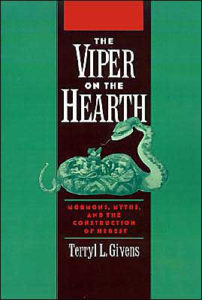 Author: Terryl Givens
Author: Terryl Givens
Title: Viper at the Hearth
Publisher: Oxford University Press
Date: 1997
Reviewed by Chad Curtis
I picked up another Terryl Givens book this week, while we still wait on his biography of Eugene England. I believe the last book I read by him was Feeding the Flock? I had to go back a bit to some of his earlier work: Viper on the Hearth: Mormons, Myths, and the Construction of Heresy (ooooh, it has heresy in the title). On the range of devotional to scholarly, this one is definitely scholarly. I mean, don’t get me wrong, it was a good book, but the genre itself took a down a few notches in my book. I’m all for well-stocked bibliographies and quality research, but the language puts you to sleep! OK, rant over. Let’s get to some content.
The book’s title comes from a common portrayal of Mormonism in nineteenth century media: a viper (representing a threat to American culture/society) on the hearth (demonstrating how this threat is so close to home). One of the central questions the book asks (and one many Mormons like to comment on in Sunday School lessons) is: why do people hate us so much? Like, more than other marginalized groups and religions? And it’s a fair question. Givens admits some danger in pondering this question too much: we really do have a persecution complex. But Givens also points out that we really did historically receive a lot more hate than other groups out there. Shakers had crazy doctrines too: why didn’t they get equal treatment by the Protestant mainstream? Some of Givens’ theses are really quite interesting:
Mormons, unlike other groups, didn’t have geographical or ethnic space with which to distance it as a threat to American culture (aka we’re white and could be your next-door neighbor).
Anti-Mormon propaganda piggy-packed off tropes found in anti-Catholic propaganda, but couldn’t be translated directly, because Mormonism was a home-grown phenomenon.
The development of new genres of literature allowed authors to get away with a lot that would be considered irresponsible today (passing off fictional accounts as autobiography for instance, when narrating experiences with Mormonism).
The meat of the book centers around portrayals of Mormonism in popular fiction. It hurts to read harsh attacks on your faith, but this book is mostly looking at literature from the nineteenth century– and that distance in time actually gives it a comic effect. It’s ridiculous what some people actually wrote about the Mormons. This is one of my favorites:
They came to a square chamber, which was lighted by flaring, smoking torches. In a semi-circle at one end of the chamber sat twelve cloaked and cowled figures, their garments of somber black… Then the figure that wore the bear’s head… stood and read from the… Mormon bible.
There was something that felt a little different in this book when compared to some of the others Givens has written, and it’s kind of hard to describe, but I’ll try. Givens has done a lot of doctrinal work, I would say, to make you proud of Mormon doctrine and history, but he does it by re-interpreting it. For instance, his book on The Good Who Weeps establishes a Mormon conception of God that you may not even has known was there, all from the Pearl of Great Price. And his The Christ Who Heals takes the emphasis off Christ as remitting sins and more as a healer of wounds. In addition, I feel that he does a lot of ministering to the marginalized within the Church, making room for those who doubt, or who experience their faith differently. But this didn’t feel quite like it was in that vein. Instead, it felt more like a retrenchment into us-against-the-world Mormonism.
For instance when explaining why society reversed itself and now accept Mormons in its mainstream, he makes this comment:
[TV networks and other commentators on Mormonism] clearly engage in the use of deviance as a mirror in which the viewer’s tolerance and generosity of spirit may be reflected– or at least interrogated. The outrageousness of the transgression becomes the measure of the liberalism of spirit that can accommodate it. Difference has not been embraced– it has been prostituted to the parade of pluralism.
I’m not saying there isn’t truth to that statement: the idea that modern toleration is actually a game of one-upmanship in how crazy we can go in acceptance. But it didn’t necessarily feel like Givens’… brand? Maybe someone else can explain it better, but that’s all I got.
Either way, well-researched book, and one that will get you thinking.
